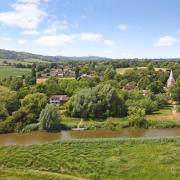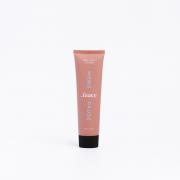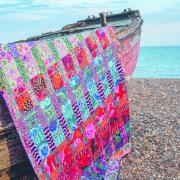Garden sheds across the planet hide a little bit of Sussex heritage: baskets made of sweet chestnut and willow, ideal for transporting a muddied trowel or just-harvested fruit and veg.
The Sussex trug is one of our great local crafts with a history spanning 200 years. Over that time, they have been snapped up by monarchs and wielded by horticultural greats. And though the industry is withering, there is still a handful of artisans keeping the tradition alive.
One of those is Robin Tuppen, owner of the Cuckmere Trug Company in Herstmonceux. Over his decades-long career, he has shipped baskets worldwide, including to the royal estate at Windsor Castle and to Hollywood royalty in the form of Meryl Streep.

‘I’ve had a lot of successful moments over the years,’ he says. ‘I’ve enjoyed doing what I do, but there have been times when it’s been very stressful.
‘Currently it’s very stressful because the cost-of-living situation isn’t helping anybody in small businesses. But overall, I’ve had some very interesting times. I’ve met a lot of interesting people, not all of who have been famous. Some have, but the majority have been just ordinary people. If I didn’t enjoy it, I would have retired 10 years ago.’
Robin, 75, assembled his first trug in 1990, seven years after forming South Down Trugs & Crafts in Bexhill-on-Sea with his older brother Peter. Originally, they created a contemporary plywood version of the trug, which they named the South Down Range. In 1989, they purchased Thomas Smith’s Trug Shop, makers of the original sweet chestnut and willow trug.

Robin now makes both styles with his team of three as the Cuckmere Trug Company, fashioning 3,000 or so baskets a year, around 40 percent of which are shipped abroad. Of those, approximately 75 percent are the sweet chestnut and willow variety and the rest made of ply.
Though he initially started on the sales side of the business, he has since demonstrated trug making abroad, winning ribbons for his presentations at gardening shows.
Creating a trug from sweet chestnut and willow is a difficult skill to master. First, the craftsperson takes a pole of sweet chestnut for the handles and rim and splits it with an axe. Those pieces are then carefully trimmed to the correct width and thickness using a drawknife (a two-handled blade used to shave and trim wood) before they are steamed to make them pliable.
The maker then has just a few seconds to wrap the wood around a solid block known as a former before it sets. When the handles and rim are both shaped, they are nailed together to create a frame. Finally, lengths of willow – cut and shaved to the correct size – are steamed or dunked into hot water before being secured onto the frame with tacks.

The difficulty in making trugs is highlighted on weekend-long courses Robin organises at various venues, including at the Weald & Downland Living Museum in Singleton and Mantel Farm in Catsfield near Battle. Over two days, novice crafters follow the lead of an expert and fashion their own basket, which they then take home with them.
‘The first day [the novices] do the cleaving [splitting the wood] and the shaving,’ Robin explains, ‘the second day they do the steaming and the bending. And then they do the assembly in the afternoon. What I say to them is: “What I’m asking you to do over two days, I’d expect my guys to do in two hours”.’
The construction method is one perfected over two centuries. Thomas Smith, a hoopmaker from Windmill Hill, Herstmonceux, is said to have invented the original Sussex trug in the 1820s. His design modernised a solid-wood basket that had been used locally since Saxon times when it was known as a trog.
His basket was more lightweight than the trog and made use of local sweet chestnut, which was introduced to the South East by the Romans, and cricket bat willow, which flourished in the Pevensey Marshes.

His big break came in 1851 when Queen Victoria saw his work on the opening day of the Great Exhibition in Hyde Park, London, and placed an order, which she intended to give as gifts to members of the royal family. Legend has it that Smith, wanting to make sure the shipment arrived safely, piled the trugs into a wheelbarrow or handcart and marched them 60-odd miles from his Herstmonceux workshop to Buckingham Palace.
Trugs were particularly popular within farming, where they were used for all manner of daily tasks, including collecting vegetables from the fields and transporting cattle feed. The baskets came in a variety of set sizes, from one pint to a bushel - around 35 litres -, which helped fieldworkers to measure their produce.
In fact, trugs were so important to agriculture that the craft was marked as a reserved occupation in both world wars, meaning trug makers were exempt from conscription.
After the Second World War, the agricultural industry embraced mechanisation and the need for trugs diminished. Their popularity continued, however, with horticulturalists who remain the primary buyers today.
‘They’re very light in weight, so easily carried,’ Robin says. ‘People can choose the size that fits them best.

‘They’re so useful to carry all your tools, to harvest anything you've got in the garden. They’re very robust as well. If you look after your trug, it’ll last you 20, 30, 40 years. Even longer sometimes.’
He adds that, on top of their practicality, some people get rather attached to their baskets, explaining that one lady in Australia bought a trug to hold logs for her new wood-burning stove and decided it needed a name.
‘She sent me a photograph of the wood-burning stove and Trevor the Trug having a glass of wine together,’ Robin smiles. ‘Then she bought a flower trug when she came in the next time and that one went back and was friends with Trevor. She was called Theresa. We’ve got some photographs of Trevor and Theresa in the mountains having a picnic, and on the beach at Christmas.’
Still, despite their popularity and sentimental pull, trugs - and more accurately the industry - is suffering.
Heritage Crafts, a national charity aimed at protecting traditional UK crafts, lays the blame at overseas competition, stating: ‘Chinese-made imitations of the Sussex trug have flooded the world market, thus reducing the number of genuine Sussex trugs made and sold.’ It also notes that ‘potential customers are not necessarily aware of the difference between a genuine Sussex trug and an imitation.’
Robin predicts the industry will disappear completely within the next 20 years unless new talent is brought through and the financial situation for local makers improves.

His dream now is to build a not-for-profit heritage centre in Wealden, which would provide a space for courses in traditional crafts, while also acting as a shop and visitor attraction where people can watch professional makers in action and learn more about the artisanal skills.
That, he hopes, could finance apprenticeship schemes, bringing fresh blood to the trug industry, and he is now looking for grant funding and volunteers with experience in fundraising or running a successful company to help build his dream.
‘As I am now well over retirement age,’ Robin says, ‘I need to ensure that the Sussex Trug industry survives into the future and I think that the heritage centre is the best way forward to protect and preserve the traditional craft.’
‘For the Sussex trug industry,’ he adds, ‘it’s the last-chance saloon.’
To buy your own Sussex trug, visit the Cuckmere Trug Company at www.sussextrugs.com. And to volunteer for the proposed heritage centre, send an email to robin@sussextrugs.com.



























